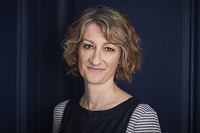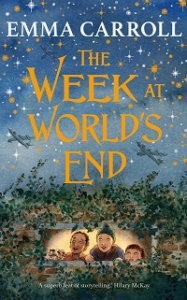
An Interview with Emma Carroll
Michelle Pauli talks to ‘queen of historical fiction’ Emma Carroll about her new book, The Week at World’s End.
What would you do if you had one day to do whatever you liked before the world ended? What might seem like fun speculation today felt very real in 1962, at the height of the Cuban missile crisis.
That fevered 10-day long period of history is the setting for The Week at World’s End by ‘queen of historical fiction’ Emma Carroll and it’s a compelling read. In the shadow of the threat of war and global annihilation, three children embark on their own adventure and each discovers their own power.
It is certainly a fascinating period to look back on. ‘There was this real sense of the world being on the brink of something really terrible happening,’ explains Carroll. ‘But when I started looking into 1962, there were also so many lovely, interesting little bits of history that I could bring into the story that I knew I’d found my era. It was a joy writing a book set in that time – the Beatles’ first single came out in October 1962, there was the civil rights movement in America… It felt like this very momentous time, where there was a lot of very positive things and change happening, but also a sense that it could all go really horribly wrong quite quickly.’
Carroll was also able to draw on her own parents’ memory of that time, from her mother recollecting coming out of the school exam hall after resitting her maths O-Level and learning that the world may be about to end, to her father sharing how much he earned on his paper round and just how exciting it was to try the new flavour of crisps – cheese and onion!
 Against the cold war backdrop, and at the centre of the story, are Stevie, Ray and Anna. The story opens with quiet Stevie discovering a dead girl in the coal shed who turns out to be very much alive and convinces Stevie and her best friend Ray that she is on the run from people trying to poison her. Amid the central mystery surrounding Anna, Carroll weaves in family disputes and grief, Ray’s African American heritage, the power of protest and Stevie finding her voice. Each of the three children is also dealing in their own way with the legacy of the second world war, the threads of which all come together in a satisfying ending.
Against the cold war backdrop, and at the centre of the story, are Stevie, Ray and Anna. The story opens with quiet Stevie discovering a dead girl in the coal shed who turns out to be very much alive and convinces Stevie and her best friend Ray that she is on the run from people trying to poison her. Amid the central mystery surrounding Anna, Carroll weaves in family disputes and grief, Ray’s African American heritage, the power of protest and Stevie finding her voice. Each of the three children is also dealing in their own way with the legacy of the second world war, the threads of which all come together in a satisfying ending.
Although Carroll was at the stage of tackling the book’s extensive edits against the clock as the pandemic struck, like many authors she struggled to write at all during the first lockdown. Combined with the publishing industry going into near shutdown mode, the book’s publication was put on hold, giving Carroll time to find her writing feet again and to reflect and redraft, ending up with ‘the story that needed to be told’.
‘It felt like I was writing a story about a really dramatic period in history and actually living through something pretty dramatic myself at the time and it felt quite troubling,’ she explains. ‘I could read but not write a word. Sometimes when you’re writing, you feel more secure in the story if you’re secure in yourself rather than feeling completely unsettled. I think I needed to be in a steady place in order to write that trauma for my characters rather than trying to deal with my own anxiety at the same time.’
The rise of the Black Lives Matter movement in summer 2020 also fed into the narrative, with Carroll’s concern to emphasise that protest is a democratic right and that small actions can make a difference.
‘BLM – and Greta Thunberg – taught us that people have currency and people when they join together have currency and people who maybe feel who feel like they haven’t got a lot of power through conventional channels actually have a voice that needs to be heard. It’s really important that children understand that: you do have a part to play in the world and you are worth listening to, and if you feel strongly about something, then it is your right to protest.’
Carrol ranges far and wide historically. Her previous books have included the gorgeous second world war-based Letters from the Lighthouse (fans will enjoy meeting Queenie again and even a guest appearance by the lighthouse in The Week at World’s End, during the children’s ‘end of the world day’), Secrets of a Sun King, about the discovery of King Tutankhamen’s tomb in 1922, and The Somerset Tsunami, set in 1616.
However, writing historical fiction, in fact becoming a writer at all, wasn’t a given. Carroll read and wrote voraciously as a child but, while her passion for reading continued through her English degree and career as an English teacher, which she loved, it took a momentous life event to return her to writing. A diagnosis of advanced breast cancer when she was 34 was a bolt from the blue and ‘the moment where the life I thought I was going to live and the life that I had to live… the path forked. It was a completely life-changing situation.’
‘I remember at that time thinking, well, if I don’t make it to 40, what’s the thing that I really want to do? What’s the thing that I still haven’t done in my life yet? It was writing.’
Taking her class to a writing residential at the Arvon Foundation in Devon had a profound impact on her and it was where she started writing what was to be her first published novel, Frost Hollow Hall. The renowned Bath Spa creative writing MA followed and, by her third book, In Darkling Wood, she was able to give up teaching and write full time. For Carroll it was a long-time dream come true:
‘I remember driving to school as an exhausted newly qualified teacher and having this daydream of if I won the lottery – which I didn’t even play! – what I’d love to do is live in a cottage in the country and write books.’
Since then she has written prolifically and has a busy year ahead. Most excitingly, she’s written a sequel to Eva Ibbotson’s much-loved classic Journey to the River Sea. But that’s not all. There is also another Faber book in September – The Houdini Inheritance – and then a Christmas book in November, a feminist retelling of The Little Match Girl.
There won’t be much time for Carroll to relax in 2022 but how would she spend the last day on earth? ‘A gallop on a horse across a beach, followed by a walk through a snowstorm – blissful!’
Michelle Pauli is a freelance writer and editor specialising in books and education. She created and edited the Guardian children’s books site.
The Week at World’s End is published by Faber and Faber, 978-0571364435, £12.99 hbk





